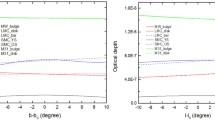THERE is now abundant evidence for the presence of large quantities of unseen
matter surrounding normal galaxies, including our own1,2. The nature of
this ’dark matter‘ is unknown, except that it cannot be made of normal stars,
dust or gas, as they would be easily detected. Exotic particles such as axions, massive
neutrinos or other weakly interacting massive particles (collectively known as WIMPs)
have been proposed3,4, but have yet to be detected. A less exotic
alternative is normal matter in the form of bodies with masses ranging from that of a
large planet to a few solar masses. Such objects, known collectively as massive compact
halo objects5 (MACHOs), might be brown dwarfs or ‘jupiters’
(bodies too small to produce their own energy by fusion), neutron stars, old white dwarfs
or black holes. Paczynski6 suggested that MACHOs might act as
gravitational microlenses, temporarily amplifying the apparent brightness of background
stars in nearby galaxies. We are conducting a microlensing experiment to determine
whether the dark matter halo of our Galaxy is made up of MACHOs. Here we report a
candidate for such a microlensing event, detected by monitoring the light curves of 1.8
million stars in the Large Magellanic Cloud for one year. The light curve shows no
variation for most of the year of data taking, and an upward excursion lasting over 1
month, with a maximum increase of ∼2 mag. The most probable lens mass, inferred from
the duration of the candidate lensing event, is ∼0.1 solar mass.



Similar content being viewed by others
References
Trimble, V. A. Rev. Astr. Astrophys. 25, 425–472 (1987).
Fich, M. & Tremaine, S. A. Rev. Astr. Astrophys. 29, 409–445 (1991).
Primack, J. R., Seckel, D. & Sadoulet, B. A. Rev. Nucl. Part. Sci. B38, 751–807 (1988).
Kolb, E. W. & Turner, M. S. The Early Universe (Addison Wesley, New York, 1990).
Griest, K. Astrophys. J. 366, 412–421 (1991).
Paczynski, B. Astrophys. J. 304, 1–5 (1986).
Bennett, D. et al. Ann. N.Y. Acad. Sci. 688, 612–618 (1993).
Alcock, C. et al. Astr. Soc. Pacif. Conf. Ser. 34, 193–202 (1992).
Magneville, C. Ann. N.Y. Acad. Sci. 688, 619–625 (1993).
Udalski, A. et al. Ann. N.Y. Acad. Sci. 688, 626–631 (1993).
Stubbs, C. W. et al. in Charge-coupled Devices and Solid State Optical Sensors III (ed. Blouke, M.) Proc. of the SPIE 1900, 192–204 (1993).
Schechter, P. L., Saha, A. & Mateo, M. L. Publs astr. Soc. Pacif. (in the press).
Cook, K. H. et al. Bull. Am. Astr. Soc. 24, 1179 (1993).
Richer, H. B. & Fahlman, G. G. Nature 358, 383–386 (1992).
Author information
Authors and Affiliations
Rights and permissions
About this article
Cite this article
Alcock, C., Akerlof, C., Allsman, R. et al. Possible gravitational microlensing of a star in the Large Magellanic Cloud. Nature 365, 621–623 (1993). https://doi.org/10.1038/365621a0
Received:
Accepted:
Published:
Issue Date:
DOI: https://doi.org/10.1038/365621a0
- Springer Nature Limited
This article is cited by
-
Is there a black hole in the center of the Sun?
Astrophysics and Space Science (2024)
-
Astrophotonics: astronomy and modern optics
The Astronomy and Astrophysics Review (2021)
-
Free-floating planets in the Milky Way
Arabian Journal of Mathematics (2019)
-
Twenty-five years of using microlensing to study dark matter
Nature (2018)





